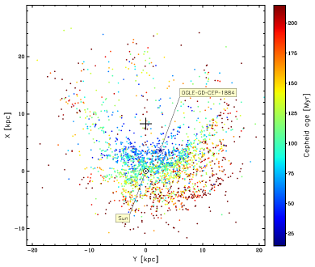The discovery of a record-breaking Cepheid in the Milky Way
2024-04-22
Information from the Astronomical Observatory of the University of Warsaw

Astronomers from the Astronomical Observatory of the University of Warsaw involved in the Optical Gravitational Lensing Experiment (OGLE) project have discovered a classical Cepheid with the longest pulsation period in our Galaxy. The new, record-braking star was identified by Professor Igor Soszyński, the world leader in the variable star field. The Cepheid was designated as OGLE-GD-CEP-1884 and pulsates with a period of 78.14 days, nearly 10 days longer than the pulsation period of the previous record-holding Cepheid, S Vulpeculae.
Classical Cepheids are young and massive variable stars that play a crucial role in astrophysics. Exactly 100 years ago, in 1924, the American astronomer Edwin Hubble used the period-luminosity relationship exhibited by Cepheids to demonstrate that the Universe contains a countless number of galaxies, rather than solely our Milky Way as previously believed. Several years later, observations of Cepheids in neighboring galaxies enabled Hubble to discover the expansion of the Universe, eventually leading to the formulation of the Big Bang theory. Today, classical Cepheids are widely employed for measuring intergalactic distances and investigating the structure of galaxies. Currently, the most precise measurement of the Hubble constant, which determines the rate of the Universe's expansion, relies on Cepheids.
The OGLE project, led by Professor Andrzej Udalski, has a longstanding tradition of discovering and studying pulsating stars. Astronomers from the University of Warsaw have discovered approximately half of all currently known classical Cepheids in the Milky Way. Several years ago, a team led by Professor Dorota Skowron published a three-dimensional map of our Galaxy based on the spatial distribution of Cepheids discovered by OGLE. This map unequivocally showed that the Milky Way's disk is not flat but is warped into an S-shape.

The newly discovered star OGLE-GD-CEP-1884 belongs to a very rare group of Cepheids with extremely long pulsation periods, known as ultra-long-period Cepheids (ULPCs). A notable characteristic of these objects is their high luminosity, which is utilized to measure distances to galaxies located up to 300 million light-years away from us. So far, not a single ULPC has been known in our Galaxy, although most surveyed galaxies contain at least several such Cepheids. Despite being over 25,000 times brighter than the Sun, OGLE-GD-CEP-1884 was not correctly classified as a Cepheid earlier because it is located behind a thick layer of interstellar matter, which absorbs most of the light emitted by the object, particularly in the blue part of the electromagnetic spectrum. Long-term photometric observations of this star conducted in the red light by the OGLE team, combined with radial velocity measurements from the Gaia mission, unequivocally demonstrate that OGLE-GD-CEP-1884 is a classical Cepheid. The discovery of this object suggests that the Milky Way is not unique among other galaxies in terms of the occurrence of long-period Cepheids. The previous absence of observations of such stars in our Galaxy is likely attributed to dense interstellar dust clouds that obscure ULPCs.
OGLE-GD-CEP-1884 stands out not only as the most luminous but also likely the youngest classical Cepheid known in the Milky Way. The age of this star has been estimated to be approximately 22 million years. The period-luminosity relation for Cepheids was used to measure the distance to OGLE-GD-CEP-1884, enabling the marking of its position on the Galaxy map. The star is located 14,500 light-years away from us in the Norma Arm, in the region predominantly occupied by other relatively young Cepheids. The discovery of OGLE-GD-CEP-1884 will contribute to a more precise calibration of the period-luminosity relation for Cepheids and a better understanding of the evolution of massive stars.
The paper presenting the discovery of a classical Cepheid with the longest pulsation period was published in The Astrophysical Journal Letters: „Discovery of the Longest-period Classical Cepheid in the Milky Way” I. Soszyński, D. M. Skowron, A. Udalski, P. Pietrukowicz, M. Gromadzki, M. K. Szymański, J. Skowron, P. Mróz, R. Poleski, S. Kozłowski, P. Iwanek, M. Wrona, K. Ulaczyk, K. Rybicki, M. Mróz, 2024, ApJL, 965, L17, https://doi.org/10.3847/2041-8213/ad392f
Illustrations:
OA240422b_fig01.png
Milky Way over the OGLE project telescope at the Las Campanas Observatory in Chile. The star symbol indicates the position of the newly discovered Cepheid, OGLE-GD-CEP-1884, on the sky. The remaining yellow dots mark positions of other known Cepheids, discovered mainly by the OGLE survey (Credit: J. Skowron, K. Ulaczyk).
OA240422b_fig02.png
Blue dots present the observed changes of brightness of the Cepheid OGLE-GD-CEP-1884 in the red band (left panel) and the visual band (middle panel), as well as the radial velocity curve (right panel). The orange curves depict model light and radial velocity curves derived for a Cepheid with a pulsation period of 78.14 days. The very good agreement between the observed and theoretical data confirms that OGLE-GD-CEP-1884 is a classical Cepheid (Credit: I. Soszyński).
OA240422b_fig03.png
Face-on view of the Milky Way traced by 2388 classical Cepheids with known distances. The colors of the points indicate the ages of the Cepheids (as shown by the scale on the right side). The position of OGLE-GD-CEP-1884 is marked by the star symbol (Credit: I. Soszyński).





